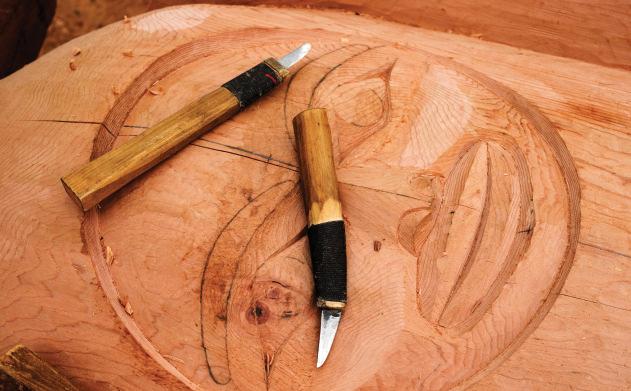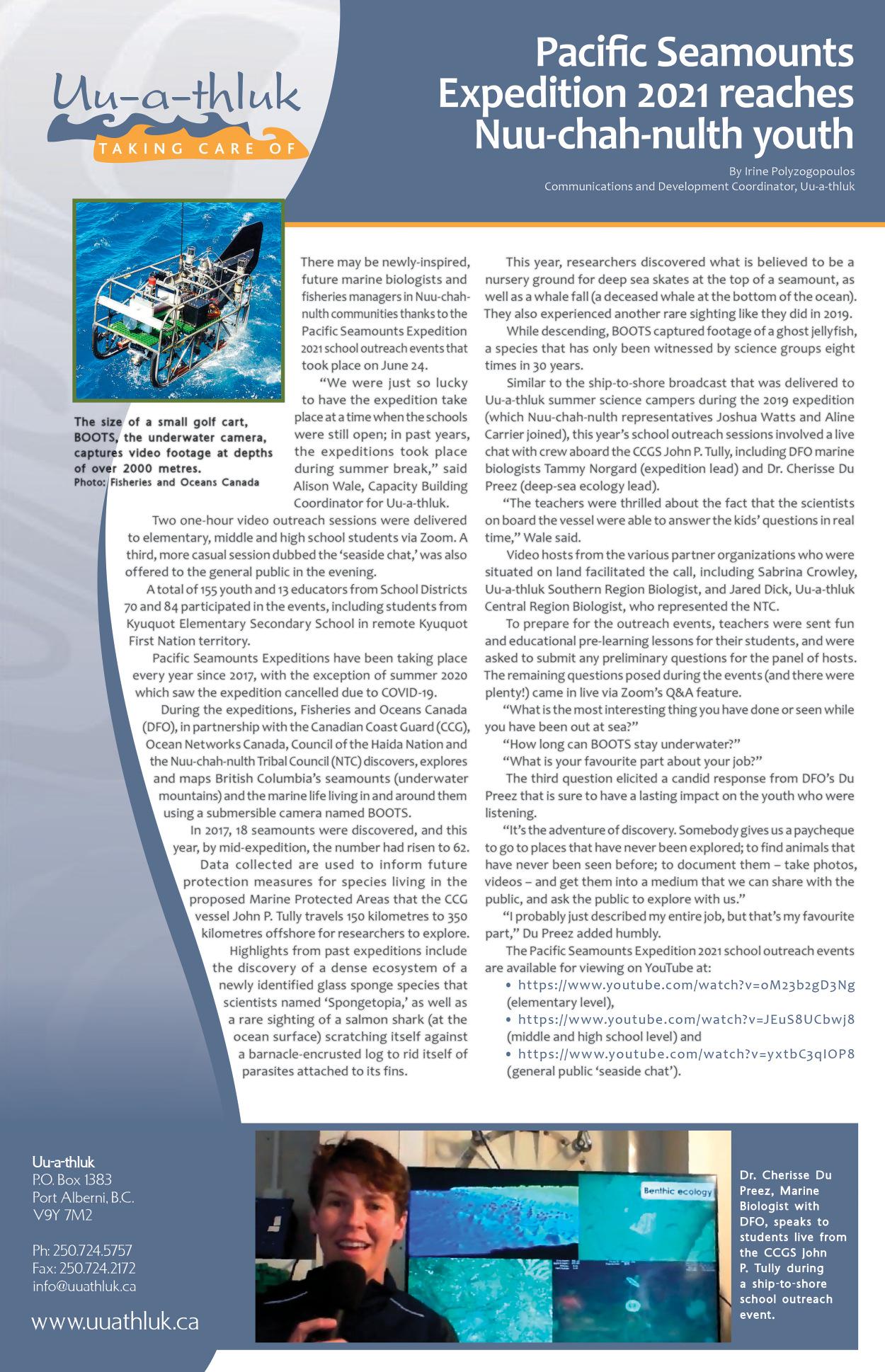
34 minute read
Carving project leads path to Nitinaht Lake
Intergenerational mentorship comes full circle as local children help carve a project that leads to Nitinaht Lake
By Denise Titian Ha-Shilth-Sa Reporter
Advertisement
Malachan, BC – World renowned artist Art Thompson was honored in his home territory June 28, 18 years after he lost his battle to cancer. A carving project, three years in the making, came to a fi nish with a solemn ceremony under sweltering summer skies. In 2018, staff of the Ditidaht Community School along with former elected chief Jack Thompson came up with an idea that would not only commemorate Art Thompson, but would also serve as a learning opportunity for the children. The school had built a trail leading from the edge of the village to the shores of Nitinaht Lake. A stunning, new carved gateway was made to grace the entrance to the trail. Designed by Morris (Moy) Sutherland Jr., the pole features two carved fi gures supporting a canoe that extends across the tops of the poles. For Moy, this project was especially important for him to complete, even after delays caused by the pandemic. More than 20 years ago Moy began his artistic apprenticeship under Art Thompson. “He was my teacher and mentor for the last three years of his life,” Moy told the crowd, adding that it was a great honor to make this contribution to the community and to the children. Thompson was born in Whyac, near Nitinaht Narrows in 1943. From an early age he was exposed to institutions that stifl ed his Indigenous ways, fi rst at the tuberculosis hospital in Nanaimo and then at Alberni Indian Residential School, where he suff ered horrifi c abuse at the hands of supervisor Arthur Plint. In 1995 Thompson testifi ed in court against Plint, who subsequently pled guilty to sexually assaulting 18 victims between the ages of 6 and 13. By that time, Thompson had found healing in artistry and his work was in demand around the world. He designed two of the medals used in the 1994 Commonwealth Games and also the Queen’s baton. He remained a staunch supporter and advocate for residential school survivors until his passing in 2003.
Photo by Denise Titian Moy Sutherland Jr. (left) stands with Tim Sutherland and Guy Louie Jr. under a recently completed carving project that serves as the gateway to a new trail leading to Nitinaht Lake. “This is the best way and the best place to honour my teacher,” said Sutherland. The new installation sits at the head of the new trail leading to Nitinaht lake. There are two fi gures, one holding a rattle. “This is a whaler above a humpback whale,” said Sutherland. He went on to say the design was inspired by an Art Thompson installation at Camosun College. The second fi gure is a Ditidaht fi sherman standing in a river fi lled with salmon. “This represents the wealth of the Ditidaht,” said Sutherland. A Nuu-chah-nulth-style canoe is balanced on top of the two poles, forming a gateway. “We are honoring a man and respecting the wealth you have in your waters…that is what is represented in these poles,” said Tim Sutherland. Sutherland said he named the pole Tsaqwa-supp. That was Thompson’s name and the family has given permission to use it for the pole. “Before he died, he had a potlatch and gave away all his names,” said Sutherland. Tsa-qwa-supp is the only name he kept. Moy Sutherland Jr. (Hiishmiik), was accompanied by his uncle Tim Sutherland, who led the singing, along with Guy Louie Jr., who helped with both carving and singing. John Marston (Qap’u’luq) of Stz’uminus First Nation was there and also took part in the project. Following a blessing ceremony, Marston thanked the people of Ditidaht and the Thompson family for their support. DCS principal Emily MacLennan thanked Sutherland and Marston for working with the kids as they helped carve one of the poles. The original plan was to have most of the work done in the village with community members helping along the way, but the pandemic changed things and the work was completed off site. Sutherland said initial funding for the project came from Ditidaht First Nation, then an anonymous donor contributed the rest to complete the work. DFN supplied the footings and built the bases for the poles.
Phrase†of†the†week:†%ukw’ic^nis%a>†p’ip’iskuk†+uuc^i%a>quun†h=aa†yaq’itii%a>†wik†wa>š†i+†
Pronounced ‘Oo Qi itch nis Pi Pi ic h kool Clue chil alth qoon Haa Yaq it tii alth Wick Walth silt ’, it means ‘We wear orange to remember those who never came home.’ Supplied by ciisma.
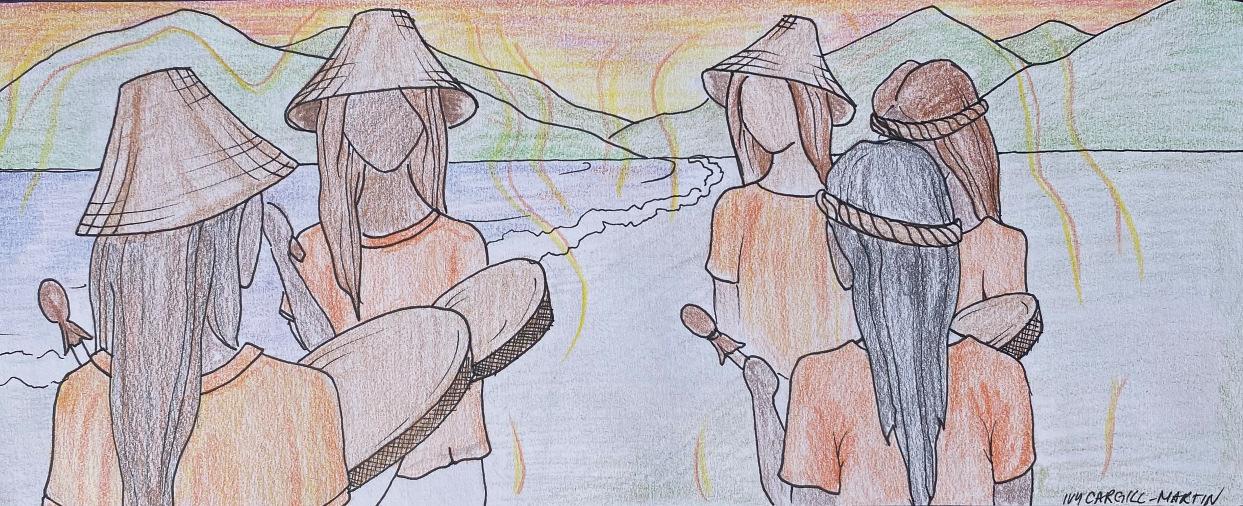
Partnership with the University of Victoria brings the Nuu-chah-nulth nation its fi rst dugout canoe in decades
By Denise Titian Ha-Shilth-Sa Reporter
Port Renfrew, BC – It has been several decades since a sea-worthy canoe has been carved in Pacheedaht territory, but that’s about to change as two youth will spend their summer apprenticing under the guidance of Makah master carver, Hawt’wilth’iayatuk, Micah McCarty. This rare opportunity came as a result of a partnership between Pacheedaht First Nation and the University of Victoria. Sarah Wright Cardinal, PhD, is an assistant professor at UVic’s School of Child and Youth Care. She told Ha-Shilth-Sa that she and former PFN health director Roxy Jones applied for a substantial UVic grant to fund the ‘Reclaiming Nuuchah-nulth teachings to empower and strengthen the roles and responsibilities of Pacheedaht young men’ program. Funded by the Social Sciences & Humanities Research Council of Canada, the project builds on a previous grant project that supported the Pacheedaht community prepare for their role in Tribal Journeys 2019. PFN was awarded a $200,000 grant last year when the pandemic began. Unable to move forward with the project due to provincial health orders, the funding was extended for a year. The team, made up of PFN and UVic staff , is developing a model of community wellness that engages youth in remote and rural Indigenous communities. Cardinal noted that the Pacheedaht, Makah and Ditidaht are all closely related. She recalled the story of the broken rattle told by Ditidaht elder Jimmy Chester. In 2019 the late elder told Ha-ShilthSa that the three nations speak the same dialect of the Nuu-chah-nulth language because they are one family. Chester explained that the Ditidaht and Pacheedaht originally came from Makah. But fear of retribution for accidentally breaking a chief’s sacred rattle sent some of the people paddling across the Strait of Juan de Fuca, fearing for their lives. Chester explained that the Pacheedaht and Ditidaht originally came from Tatoosh Island, off the coast of Cape Flattery in Washington State. They fi rst landed in what is now known as Jordan River, but there wasn’t enough food for everyone. The group split and s ome went inland to Nitinaht Lake and the others stayed on the outer coast, becoming the Ditidaht and Pacheedaht respectively. Reviving culture with Ditidaht For the past several years the Pacheedaht have been working closely with Ditidaht to revive their culture. The two nations have used previous UVic grants to hold language and cultural classes. In 2019 the university donated a pair of Nuu-chah-nulth style fi breglass canoes, allowing the Pacheedaht to take part in Canoe Journeys for the fi rst time. With the most recent grant, Pacheedaht will take it a step further and learn how to make their own canoes by having a pair of youth apprentice under McCarty. The skills they pick up will be transferable to future generations of Nuu-chah-nulth-aht. Trent Jones and Trystan Dunn-Jones will learn how to carve a canoe under the direction of their Makah relative McCarty, who underwent two weeks of quarantine before arriving in Port Renfrew. The canoe is expected to be completed in September 2021. There was a ceremony to offi cially launch the project on July 1. At that
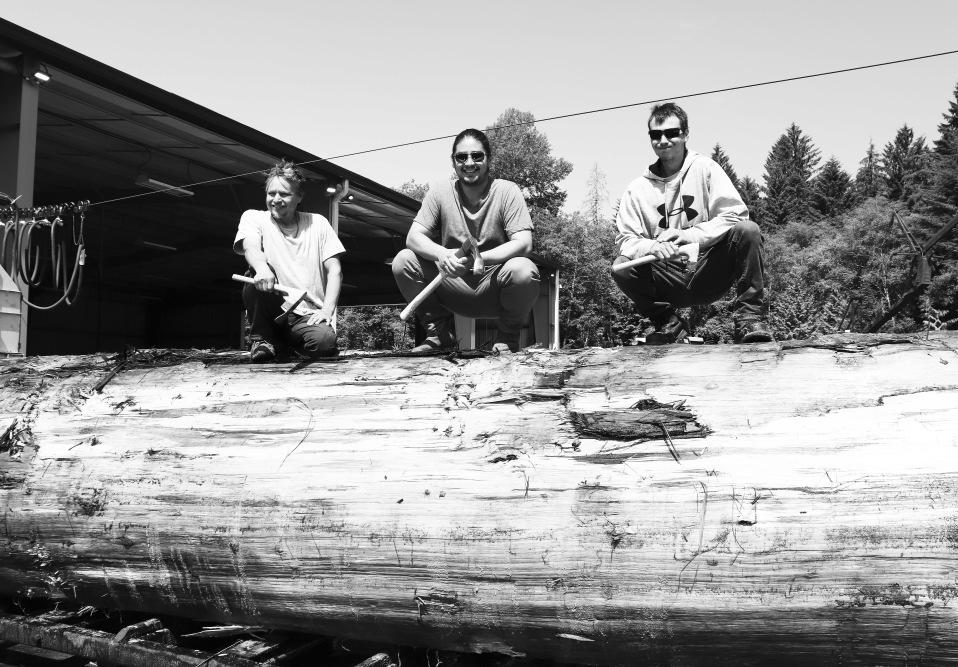
Photos by Denise Titian With traditional hand tools in hand, Makah master carver Micah McCarty and his Pacheedaht apprentices Trystan DunnJones and Trent Jones post atop and ancient red cedar recently harvested in Pacheedaht territory. Over the next two months the log will be transformed into a Nuu-chah-nulth style dugout canoe.
~ Micah McCarty
ceremony the canoe log was blessed and people involved in the project were acknowledged. Early the following morning McCarty went to the Pacheedaht Forestry Mill site to begin work on the log. According to elected chief Jeff Jones, the log, an old growth red cedar, was harvested from Pacheedaht territory. Since traditional dug-out canoes are shaped out of a single log, the occasional harvest of old growth cedar is necessary to keep the art of canoe-making alive. Chief Jones noted that there are not many mills capable of handling a log this size. In fact, a mill employee needed to use a chainsaw to cut off sections of the log so that it would fi t through the Woodmizer. McCarty and a couple mill workers took some measurements of the log, planning for the most effi cient way to mill the log. “Cedar trees have a natural curve – you need to know how to read the wood and work with that natural bend to accommodate the bow, which curves upward,” said McCarty. McCarty is a prominent leader in the Pacifi c Northwest. He has served as chairman on Makah Tribal Council. He has been to Washington, D.C. to fi ght for Makah’s whaling rights enshrined in a treaty and for environmental protections. When asked why he chose to lead this project, McCarty said, “It manifests everything I was raised to value.” McCarty made his fi rst model canoe before he was eight years old. From Grades 1-3 he attended Wa he lut Indian School at Olympia, WA., where he fi rst started carving. “A Haida carver taught me how to make a Makah model canoe,” he said. By passing on teachings like these, McCarty says it strengthens family ties and allows for the continuity of culture. “It’s about wellness for youth and it allows them to see and witness living culture,” he added. McCarty himself apprenticed under notable master carvers like Tla-o-qui-aht’s Joe Martin and others. “I’ve been around cedar all my life. I learned how to read cedar and know what shapes you can get out of a piece of wood,” he said. He says he still has a lot to learn, even after decades of projects. For that reason, he takes a careful and methodical approach to carving canoes. Eagle parts for regalia Sheila Jones is fi nishing up her fourth year of university in the Child and Youth Care Program. Returning home to work with Pacheedaht youth over the summer is her fi nal course requirement before completing her degree. She had been up late, the night before, plucking eagle carcasses. Sheila is learning to make regalia from eagle parts with the assistance of an elder in the village that was trained on the proper processing techniques and the respectful treatment of the remains once the feathers and other usable parts are removed. It is illegal to hunt eagles but, with support from PFN natural resources staff , the nation was able to acquire eagle carcasses from conservation offi cers for cultural purposes. The regalia, down and feathers will be used in future celebrations, like the blessing of the canoe when it is fi nished. These are other skills that will be passed on to PFN members both directly and through social media. Sheila talked about the importance of bringing back lost skills and the cultural lessons McCarty will bring to the community, and, more importantly, the youth. “He’s a great teacher – he explains things every step of the way,” she said. She is grateful that her nation has its own sawmill, getting days of work done in a few short hours. Ancient techniques would require that wood be chipped away with hand tools to begin shaping the canoe. With a sawmill, several slabs of wood were sawn from the log, allowing the mill to market the high-end red cedar slabs rather than turning it into wood chips. Sheila spent the morning at the mill site, live streaming the milling process for Pacheedaht members and maximizing the audience of potential learners. On July 2 the log was transported to the reserve and placed in front of the band offi ce. This allows for other members of the community to take part in the project. When asked when the last canoe was carved in Port Renfrew, Sheila recalled canoe projects from about 25 years ago. “There have been attempts and fails,” she said. One canoe cracked and the other was too unstable to use. They are hoping McCarty can repair the cracked canoe. Chief Jeff Jones said he hopes the project will not only enrich PFN culture but bring unity in his community and with the Makah and Ditidaht relatives. Both Trent and Tristan will work with McCarty throughout the summer, not only learning how to carve a canoe, but also taking in cultural teachings. “This is something to look forward to, coming out of COVID. To learn from a master carver like Makah, this opportunity is huge and rare,” said Jeff Jones. McCarty says he is happy to share what he has learned with future generations. “I will become an ancestor someday,” said McCarty. “I revere ancestors, and the more we add life to culture, the better.”
Page 14— Ha-Shilth-Sa—July 22, 2021 President’s message to Nuu-chah-nulth-aht
Hello to everyone throughout all Nuuchah-nulth territories. I hope you all were able to get through the terrible heat waves we had to live through in the past month. No one can doubt that we are in global warming when we hit record temperatures for days on end. We are in extreme dryness in the forests and encourage everyone to continue to be very careful when in the forests. It is hard to see so many forest fi res in B.C., and seeing places like Lytton and the reserve mostly burned up. Hard times for many First Nations people fi ghting fi res to keep them away from their homes and communities. The Senate Committee on Energy and Climate asked me to present to them on the new proposed federal law on getting to net zero emissions. Climate change is hitting us hard with these record-breaking temperatures, fl oods, droughts and forest fi res. If they wait until 2050 to get to net zero emissions I am not sure what kind of world we will be living in. Constant air conditioning? Not able to get out and enjoy the world? People, governments, industry and businesses must make greater eff orts to get down our greenhouse gas emissions or we won’t have much of a world to live in and what will we be passing on to our children and grandchildren. This month I attended the Zoom Annual General Assembly of the Assembly of First Nations. For the fi rst time in the history of the AFN, a woman was elected as national chief, Roseanne Archibald from the First Nation of Taykwa Tagamou and is Nishnawbe from Ontario. There were seven people running for national chief, three women and four men and during the fi fth ballot. Roseanne was declared national chief as her contender withdrew. Nuu-chah-nulth had a candidates forum before the election and we were able to question all seven candidates. Earlier in the week, an Inuk woman Mary Simon was made the Governor General Delegate, the fi rst time an Indigenous person has been Governor General. Mary is very accomplished and has had many roles throughout her lifetime. It was quite a week for Indigenous women. Of course in the last few weeks of June, we celebrated our grads and scholarship winners. Congratulations to all who graduated and got scholarships and hope you all had good celebrations of their accomplishments. It was a big thing they did. As B.C. has now opened the province, I had a meeting with Heiltsuk and the provincial and federal health teams to communicate some of the concerns being expressed by Nuu-chah-nulth nations. That is how soon the borders will open and dealing with the many US recreation boaters who come into First Nations harbours and villages. If people are coming in from the US, they have three days of isolation in a government-approved hotel and then self-isolate for another 11 days and must have a negative COVID test. I am also working with a group of chiefs to look at how we can take back more jurisdiction over health so that we may be able to control our own health, have the data we need to make good decisions and ensure our people are looked after in a good way. As B.C. is no longer in a state of emergency, Indigenous Services Canada is not providing any money to First Nations for COVID prevention activities including manning security gates at the entrance to the reserves. We continue to have our policing committee and are drafting a Memorandum of Understanding on how we will work together with the RCMP and what we want to accomplish in various areas of policing. There are so many issues in relation to policing and we must work hard to ensure there is justice for Indigenous peoples. As you know, B.C. passed the Declaration on the Rights of Indigenous Peoples Act over 18 months ago and have not done a lot to implement the law. One of the things they were to do under the law was to table a joint action plan that would set out what work would be done but did not include what laws were to be changed. At the end of June, they fi nally tabled the plan, almost 20 months later. I reviewed it and did an analysis of what needs to be changed. The plan is for the next fi ve years. The very sad news of fi nding the unmarked graves at Kamloops Indian Band and Cowessess and in Saskatchewan, Penelakut and others has hit everyone very hard. While the survivors knew these unmarked graves existed, and the Truth and Reconciliation Commission was also told, the Canadian government refused to provide money to look for them and told the commission it was not within their mandate. Both federal and provincial governments have provided funding for First Nations to do the ground-penetrating radar and it is expected that many more unmarked graves will be found. At the Union of BC Indian Chiefs and AFN, comprehensive motions were made on political action that needs to be taken. The chief from KIB said that they have comprehensive strategies for political, technical, legal, communications and international actions they will take for next steps. First Nations all over the country have been doing their own ceremonies, or going to Kamloops to do ceremonies there. The best news coming out of fi sheries is that the commercial fi shery case involving Ahousaht and others will not be appealed to the Supreme Court of Canada. After being in court for 16 years and winning one case only to have to start another to get DFO to act on commercial fi sheries, the court battle is over. Now it is working to get DFO to implement the decision that provides our commercial fi shermen with enough fi sh to make a reasonable livelihood. This will be the challenge. Congrats once again to Ditidaht, Huuay-aht and Pacheedaht on their Hišuk ma cawak Declaration and taking back management of their forestry. As always, I am always committed to working hard for all the issues Nuu-chahnulth. Enjoy your summer. - Kekinusuqs Judith Sayers WCMRC is recruiting for a Full Time Spill Response Technician – 60 GT Master to join our Port Alberni, BC spill response team. The specifi c responsibilities for this position include: • Captain vessels safely and eff ectively, provide direction to crew members and maintain records of allocated personnel and resources • Ensure all activities are carried out with due regard to personal safety • Provide safe, prompt and effi cient support to spill incidents, exercises and preparedness projects. • Maintain spill response equipment to ensure all equipment is operational • Ensure crew is fully trained and successfully executes assigned tasks during exercises, drills and oil spill response operations. • Participate in exercises, trains contractors and WCMRC personnel. • Provide training to our new hires/ casuals/ contractors. The successful candidate will possess a Master 60 GT Domestic certifi cate issued by Transport Canada, a minimum of three years of previous experience with marine and small power equipment maintenance, working knowledge of local coastlines, and emergency response training and/or experience. A Class 5 Drivers License is required. Must be physically fi t for work at sea in calm and rough waters and be willing and able to work outdoors under inclement weather. Also, must be capable of lifting and carrying up to 50lbs on a regular basis.
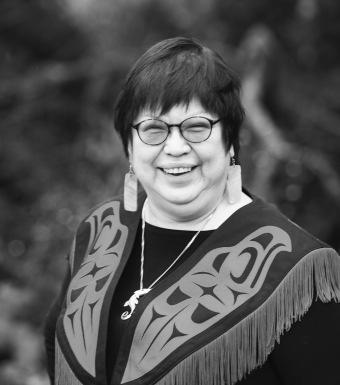

To view full job posting or to send a cover letter and detailed resume visit our website at http://wcmrc.com/careers/

July 22, 2021—Ha-Shilth-Sa—Page 15 ---Employment Opportunities---
Port Alberni Friendship Centre Volunteers Needed
Need work experience? The Port Alberni Friendship Centre is looking for interested applicants for various positions. Hours per week vary. Call 250-723-8281




View more job postings at hashilthsa.com
Program fi nds employment opportunities by working with First Nations to identify environmental restoration
By Melissa Renwick Local Journalism Initiative Reporter
Tofi no, BC - After many years working as a health care aid, Kayla Lucas needed a change. Unsure of which direction to go next, the Hesquiaht First Nation council member took a job preparing willow for replanting with the Central Westcoast Forest Society (CWFS). “I had no idea what I was doing or what to expect,” she described. At the time, Lucas said she knew little about working in fi sheries, forestry, or environmental conservation. But after carrying out various work contracts with the non-profi t organization, her interest peaked. Before long, Lucas was asked to participate in a technical training certifi cation program that the CWFS was facilitating and without hesitation, she agreed. “[The training] opened many doors for me,” said Lucas. “It also opened up something I didn’t realize I was interested in.” Funded through B.C.’s Healthy Watersheds Initiative, eight participants from Tla-o-qui-aht, Hesquiaht and Ahousaht First Nations attended the 5-week training between April 19 to May 21. Held at the Best Western Plus Tin Wis Resort in Tofi no, they learned about fi sh and fi sh habitat, land monitoring skills, water monitoring skills, and essential environmental skills. “[Participants] identifi ed roles and responsibilities for environmental monitoring crews, they were able to conduct standard measuring and sampling techniques and learn about turbidity monitoring,” explained Mandala Smulders, CWFS director of operations. Off ered on a fi rst-come fi rst-serve basis, the training was not only free, but Smulders said participants were compensated to attend. Although CWFS did not pay for their
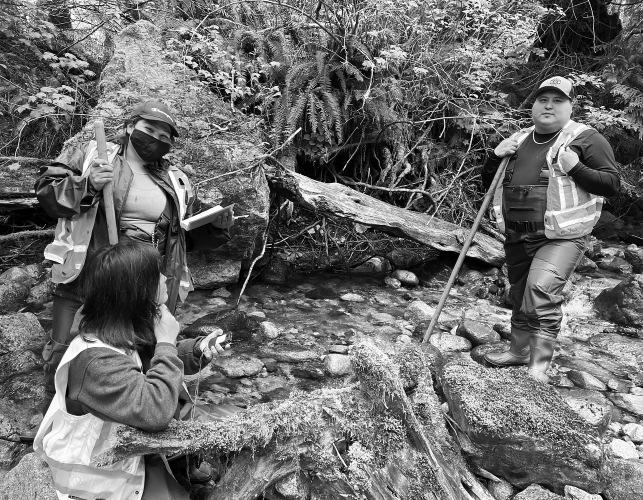
Photo supplied by CWFS Participants engage in a fi ve-week technical training certifi cation facilitated by the Central Westcoast Forest Society (CWFS) between April 19 to May 21 near Tofi no. tuition, participants from the neighbouring nations of Ka:’yu:’k’t’h’/ Che:k’tles7et’h’ and Yuułuʔiłʔatḥ First Nations also joined. The goal was to provide those involved with a variety of environmental specializations that they could carry with them into the fi eld within their own territories, Smulders said. After completing her certifi cation, Lucas landed a job working in her home territory on the nation’s hydro project at Ahtaapq Creek as an environmental technician. She remembers being a young adult when the hydro project was “just a dream.” The late-chief Richard Lucas was just putting it into motion, she recalled. “Being a really big part of this project now is amazing,” she said. “Every time I’m out there, I can’t help but think of [Richard]. I know he’s looking down and just so proud of this project. This was his baby, this was also his stress, but he made it happen. We’re just carrying out what he was able to do for our nation.” The Maaqutusiis Hahoulthee Stewardship Society has also employed two of the certifi cate recipients as full-time stewardship guardians to conduct regular patrols of Ahousaht’s territory. CWFS funds the positions through the Healthy Watersheds Initiative. The society began in 1995, after the Meares Island logging protests in Clayoquot Sound. As logging was shutting down in the region, CWFS was established to provide job opportunities to those who had lost their livelihoods through restoring systems that had been degraded from logging, Smulders said. Representatives from the surrounding Tla-o-qui-aht, Hesquiaht, Ahousaht, Toquaht and Yuułuʔiłʔatḥ First Nations sit on the board of directors. Working with the nations to identify priority areas for restoration has always been one of the society’s mandates, said Smulders. By focusing on training, capacity building, and providing employment opportunities, CWFS aims to build-up a restoration-based economy, she added. Terry Dorward, Tla-o-qui-aht Tribal Parks project coordinator, said that combining traditional knowledge with CWFS’s science-based approach creates an ideal partnership. “Our mandate, our Tla-o-qui-aht vision, is to have healthy rivers producing salmon,” he said. “It goes back to our responsibilities. We’ve been trying to build a conservation economy for some time now and working with the folks at CWFS is the perfect fi t.” CWFS hopes to off er more training courses in the fall, once the peak of their restoration work has slowed down, said Smulders. For the most part, Lucas said the handson training hardly even felt like work. “It was just fun,” she said. “We were able to identify birds, get right in there and identify bugs, identify trees, identify the dozens and dozens of mosses and what their purposes are in the environment. That was my biggest takeaway – everything has a purpose, and everything has to be protected.” Lucas said the technical training made her more aware of her surrounding environment and what she can do to help keep them protected. “I learned just how important it is to make sure the streams are eff ective for our fi sh to return,” she said. “It’s really important to take care of those streams, like our ancestors did.”
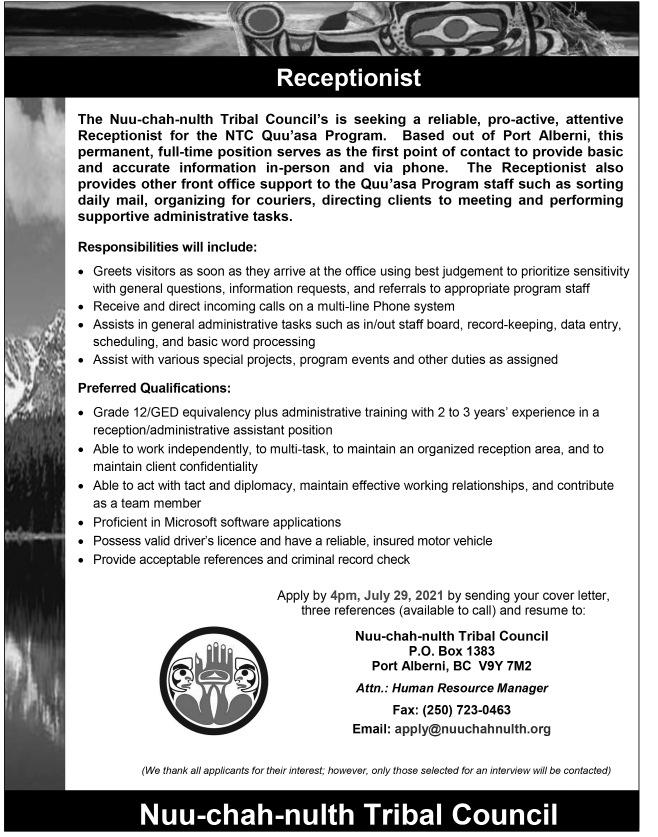


Reopened after a pandemic closure in 2020, the 75-kilometre route features a new 113-metre suspension bridge
By Mike Youds Ha-Shilth-Sa Contributor
Building a new bridge on the West Coast Trail was no walk in the park, Parks Canada says. The popular coastal trek reopened June 4 after a year-long pandemic closure, enabling hikers to cross what Parks Canada describes as a feat of construction and engineering, a 113-metre suspension bridge hanging 120 metres above Logan Creek, referred to in Nuu-chah-nulth as wi?e:? (pronounced wi-eh). “It was such an exciting project,” said Jackie Hicks, Parks Canada project manager, who was the fi rst registered hiker to cross the new span. She last hiked the 75-km trail — which traverses Huu-ayaht, Ditidaht and Pacheedaht territories between Pachena Bay and Gordon River — in 2002. This time, as a park employee, she had some fi nal inspecting to do as the season got underway. “It was an incredible experience,” Hicks said of her most recent trek. “I don’t think hikers now will realize, but we made it a little bit easier for them.” Aside from its spectacular setting, West Coast Trail is known for exposure to the elements, and countless ups and downs, as it snakes between rugged coastline and dense rainforest. Built in 1907 as the Dominion Lifesaving Trail, the route was originally intended for rescuing shipwreck survivors in an era when there were many along what was known as the Graveyard of the Pacifi c. Nowadays, about 6,000 hikers attempt the trail each season between May and September. Multiple improvements in recent years have made hiking the route safer and easier. Still, each year Parks Canada has to evacuate about 100 hikers from the trail due to illness or injury. There are more than 100 ladder systems that must be scaled en route. Logan Creek was known to be especially taxing for backpackers carrying fi ve to seven days of provisions. To reach the old suspension bridge at kilometre 56, hikers scaled down a series of wooden ladders then climbed another series of ladders on the opposite side. The new bridge allows a safer and less physically demanding crossing than before, its lengthier span bridging the ravine at a higher elevation. Instead of a single plank too narrow to allow hikers to pass each other, there is the added reassurance of aluminum planking, beams and joists as well as steel support piers. Completed in 2019, the new crossing is part of $7.9 million invested in the West Coast Trail, along with other upgrades
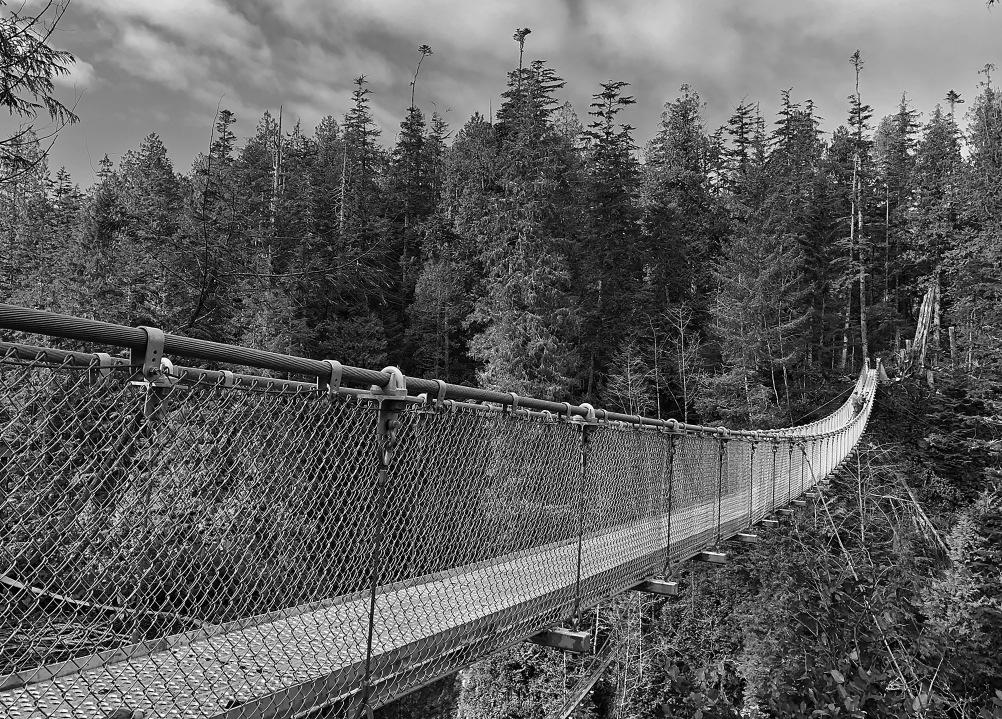
Photo submitted by Parks Canada Construction workers walk the completed bridge, which spans 113-metres abover Logan Creek. Each year about 6,000 hikers attempt to complete the West Coast Trail. including composting toilets. But the bridge at wi?e:? wasn’t replaced to make hiking easier, Hicks noted. An assessment done as part of a Parks Canada bridge inspection program several years ago found the anchoring system holding all those ladders in place was deemed inadequate due to slope instability. The old ladder system was at issue, not the bridge. Wooden rungs, susceptible to wear and tear, had to be continually replaced. A crew of about 10 workers camped along the creek during construction, equipped with nothing larger than a small excavator and a limited assortment of tools light enough to be fl own in. Pacheedaht First Nation monitors worked with Parks Canada staff on site to ensure contractors followed cultural and environmental standards. To minimize wildlife interactions, the contractor brought in a bear-safe storage container for all food and waste and a temporary electric fence was installed around the work site. All bridge components had to be airlifted by helicopter. Old components had to be fl own out for recycling. Each fl ight had to be strategically planned on account of the same natural forces that make the hike so arduous — heavy rain, fog banks and high winds. During the intense wildfi re season of 2019, there were no helicopters available, another hurdle for construction, though the bridge was completed that year. According to Parks Canada, the new span ranks among the Top 10 in B.C. in its category of simple suspension bridges. There are about 50 listed in a provincial inventory. “It is quite an improvement and, in eff ect, it’s also a beautiful, new piece of infrastructure,” Hicks said. The Golden Skybridge, which opened in May between Revelstoke and Banff , includes two spans, one of which is 130 metres high, making it the highest in Canada. The other span at Golden is equal in length to Capilano Suspension Bridge, 140 metres. The only drawback with Logan Creek Suspension Bridge, in relation to those high-profi le tourist attractions, is getting there. Hikers alone can access the bridge and they have to register in advance to use the trail. Parks Canada has produced a video about the construction of the bridge: https://www.youtube.com/ watch?v=dF9I0P_ek6s&t=3s.

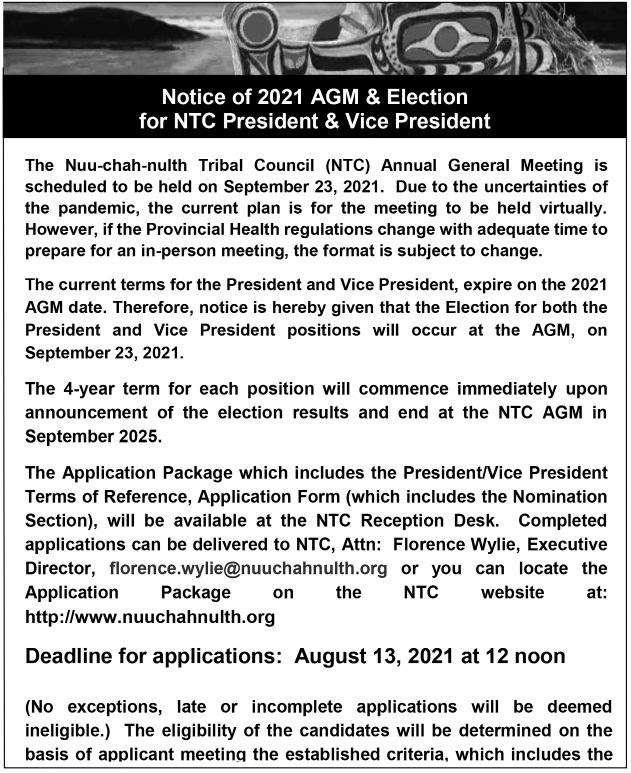
Project adds to the small collection of traditionally carved Tla-o-qui-aht totem poles that remain in existence
By Melissa Renwick Local Journalism Initiative Reporter
Tofi no, BC - Most families from Tla-oqui-aht First Nation had four totem poles displayed in front of their homes before European settlers arrived on the west coast in the late-1700s. When a woman married into a tribe, a totem pole was raised to depict her family’s history. It would stand next to three poles. One for her husband’s history, another for his parent’s history and the fourth for his grandparent’s history, according to teachings given to Joe Martin, master carver and Tla-o-qui-aht elder. For Tla-o-qui-aht families, the totem poles served as daily reminders of the teachings relatives were expected to uphold. “It’s our constitution,” said Martin. “Teachings of natural law.” 200 homes burned Today, only two totem poles from 1989 and 1993 remain in Opitsaht on Meares Island – one of which is rotting and leaning to the side, said Martin. This is why his eldest brother, Nookmis, asked Martin to carve a new totem pole for the ancient village. As Europeans fi rst arrived in the Clayoquot Sound and encountered the Tla-oqui-aht, they couldn’t make sense of the totem poles, said Martin. Just like First Nations couldn’t read English, Martin said settlers couldn’t read the totem poles. “They were also illiterate,” he said. Totem poles are not read linearly. Often carved as animals or mythical creatures, the crests hold ancient teachings that change with the seasons, said Martin. Passed down through the generations, each one tells a familial story or serves to honour a specifi c event, or person. Shaped as guiding principles, the teachings were often taught through song and dance, said Martin. As an example, Martin pointed to a sea serpent and said it represents the lightning in the sky. “It’s a teaching about being quick,” he said, recalling his ancestors who used to hunt whales. “They had to be.” In 1792, American trader Captain Robert Gray set fi re to around 200 homes in Opitsaht, along with all the totem poles that stood beside them. John Boite, one of the crew members who was ordered to burn the houses, described the village as “a work of ages,” in his diary, according to Tofi no and Clayoquot Sound: A History by Margaret Horsfi eld and Ian Kennedy. Around a century later, many totem poles were removed from Opitsaht. The Indian Act was passed by the federal government in 1876. It aimed to eliminate Indigenous culture, with the goal of assimilating First Nations, Inuit, and Métis into a Eurocentric society. Between 1884 to 1951, potlatches were banned in an amendment to the act. The law provided a framework for government offi cials and ethnologists to remove totem poles, as well as other cultural items, such as longhouse murals. Some of the only remaining relics carved in the traditional Tla-o-qui-aht style can be found at the Field Museum of Natural History in Chicago. According to the museum, the seven poles on display were carved by Shi-yus, chief of Tla-o-qui-aht First Nation, in 1890. Ethnologist Charles Newcombe acquired the poles for the Field Museum
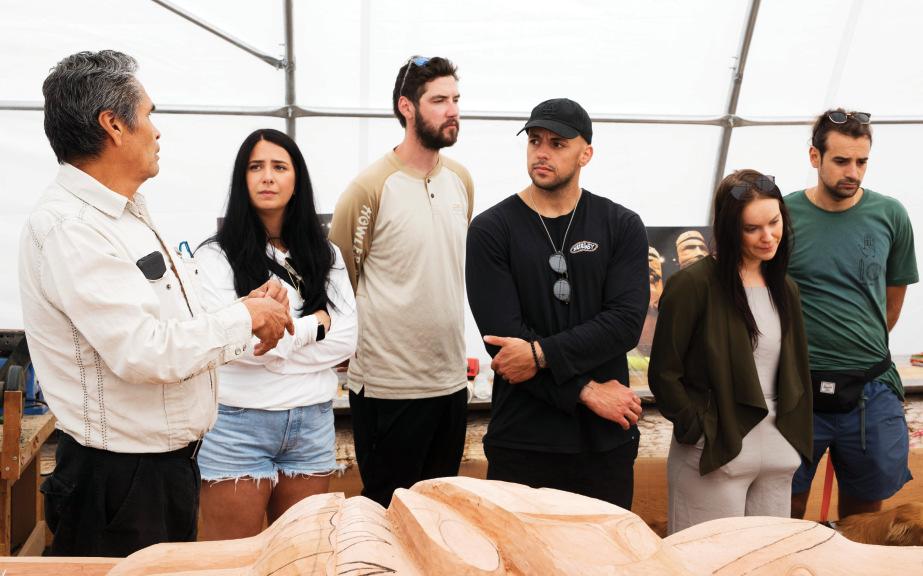
Photos by Melissa Renwick Joe Martin describes local histories to visitors from Toronto at the Tofi no Botanical Gardens, on July 9, in 1904 on a collecting expedition in the Pacifi c Northwest. Based on the museum’s records, they were sold to him by Shi-yus’ brother, Wickaninnish III, who had become Christian and acquired the name Joseph. Martin said he has never seen the totem poles in person but keeps two images of them hung in his workshop in Tofi no. Even though they’re no longer on Tla-oqui-aht’s traditional territory, Martin said that, in a way, he feels grateful because they’re still around today. Carving to remember pandemics A year and a half ago, Nookmis asked Martin to carve a new totem pole for Opitsaht. As the head of their family’s house of Ewos, Nookmis wanted it to be carved in remembrance of “the pandemic we all faced together,” said Martin. Among other crests, four skulls are carved into the lower mid-section of the totem pole. One represents the most recent COVID-19 pandemic, another symbolizes past pandemics Nuu-chahnulth peoples have endured, including smallpox and tuberculosis, the third skull honours all the Missing and Murdered Indigenous Women and Girls (MMIWG), and the fi nal skull recognizes all the children who never returned home from residential school, said Martin. With the help of various local artists, including Gordon Dick, Patrick Amos, Robin Rorick, Ken Easton and Nookmis, Martin began carving the totem pole on June 18. For Rorick, the process has been a journey of healing. The Haida artist learned to carve while working on a totem pole with his latecousin and mentor, Benjamin Davidson, around 2008. On Aug. 15, 2020, Davidson, a renowned Haida carver, suddenly passed from a heart attack. The loss continues to weigh heavy on Rorick’s mind. “I think about my late-cousin every day when I work,” he said. “When I carve on the pole with Joe, it brings back good memories of time spent with my cousin.” After a long year of being unable to socialize, Rorick said he has also found healing in being surrounded by other artists. The totem pole is being crafted from an 800-year-old red cedar tree that was felled during the construction of the Canoe Creek Hydro project, on Tla-oqui-aht territory. Long ago, some totem poles used to stand at the entrance of a longhouse with an opening carved out for passage into the house, said Martin. “You can imagine how big the trees used to be,” he said. Despite standing 32 feet tall, Martin said this new pole would have once been considered small. Part of the reason there aren’t more totem poles is that “it’s harder and harder to come by cedar,” said Rorick. “[These logs] are more and more rare.” While some artists chose to carve totem poles independently, Amos said that the collaborative process allows artists to learn new techniques from each other. “I love it,” he said. “You get to meet new friends – artists from other places and diff erent territories.” It’s a sentiment that Dick echoed by saying that it has been rewarding to learn from Martin. “[Martin’s] path of teaching and sharing has been great to be around and a part of,” said Dick. “I’m always excited to have my student ears and student eyes on in regard to what Joe shares. [It] may not even be part of this totem pole. It’s just part of our history, part of our roots.” A thunderbird is carved with its wings closed at the top of the totem pole to represent the nation’s female ancestry. For Martin, it was another way to honour the history of violence against Indigenous women. The crest of a moon sits on the bird’s chest, illustrating the nation’s fi rst rule of law – “respect,” he said. Martin scoff s at the phrase “low man on the totem pole,” which is commonly used to describe someone who is lowest in rank, or of least importance. Rather, Martin said the bottom of a totem pole is one of the most important positions. “It’s upholding all of the laws,” he added. Rekindling culture and opening secrets Martin said it’s undecided when the totem pole will be raised in Opitsaht. There are many preparations that need to be done in advance, including holding a potlatch ceremony. After enduring many recent losses, including the death of Chantel Moore, who was fatally shot by an Edmundston police offi cer during a wellness check in June 2020, Martin said his family needs to release their pain before the totem pole can be raised. As visitors, friends and family stop by the carving tent set up at the Tofi no Botanical Gardens, Martin said a conversation has been sparked. The totem pole has opened a space for people to learn about local histories, heal from the pandemic, honour ancestral teachings, remember the MMIWG, and commemorate the children who never returned home from residential school. While cultural ceremonies and teachings were once forbidden, Martin said they no longer need to be kept secret. “In a way, the totem pole helps to rekindle our culture,” said Martin. “To understand who we really are.”
